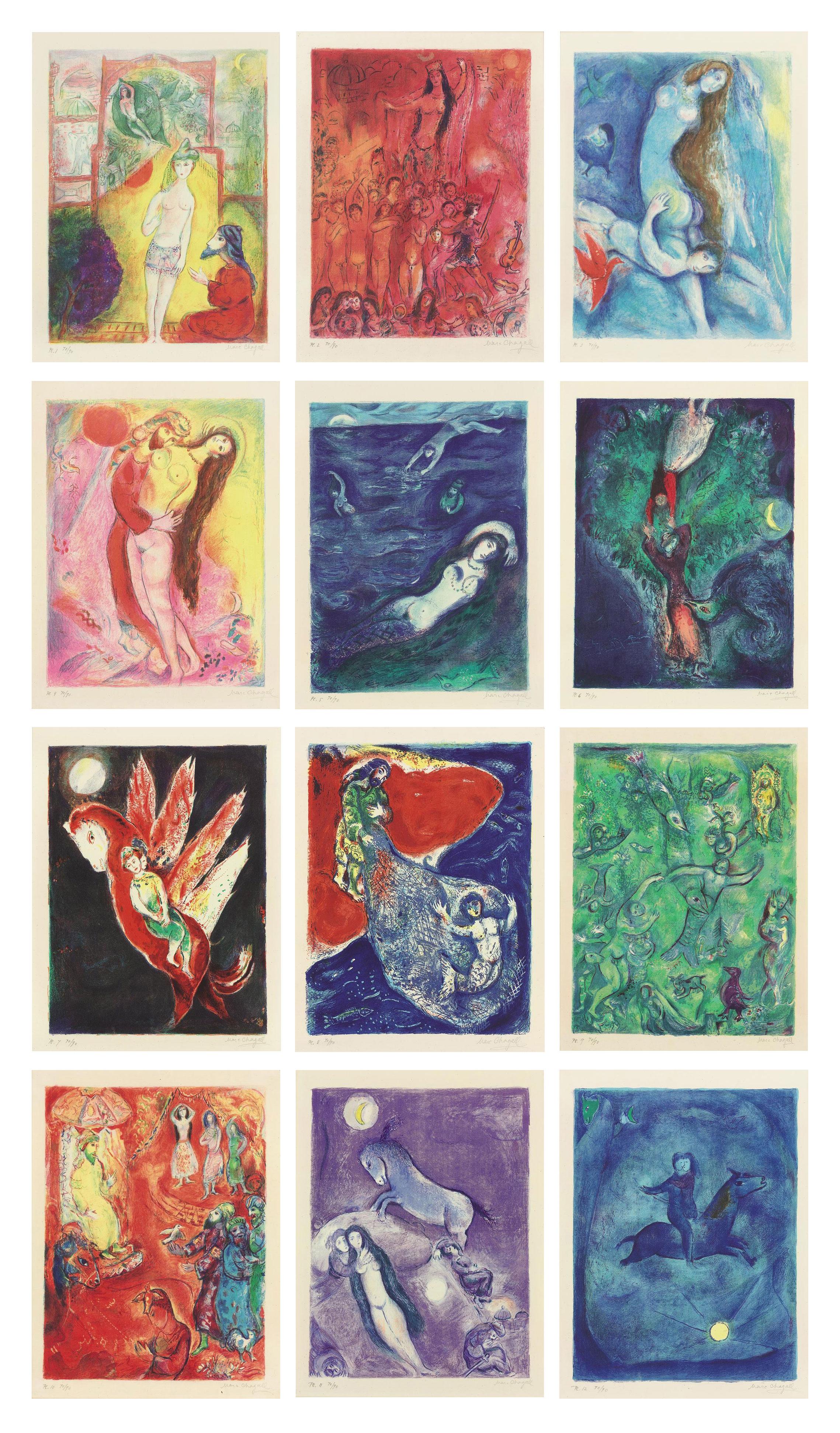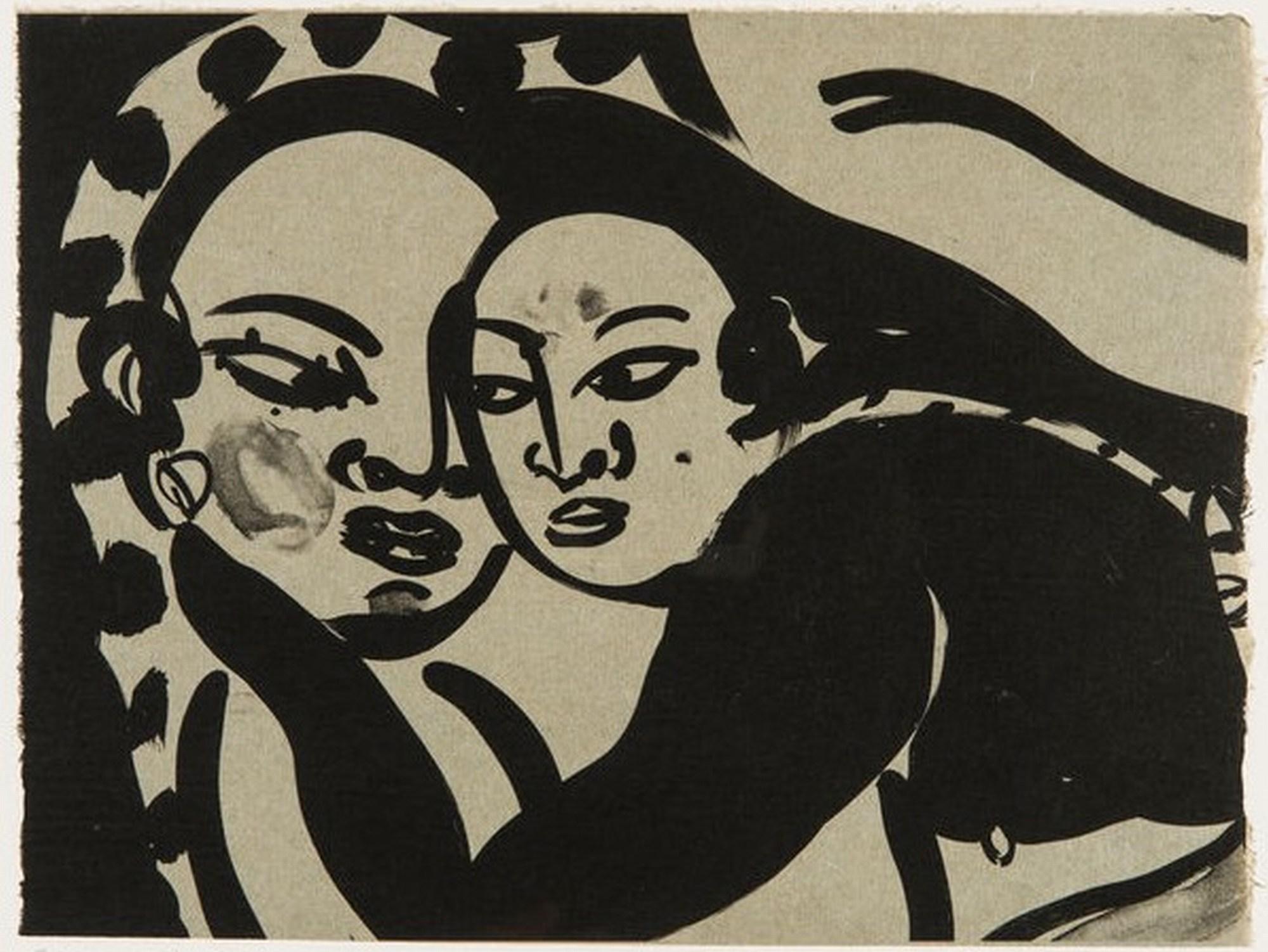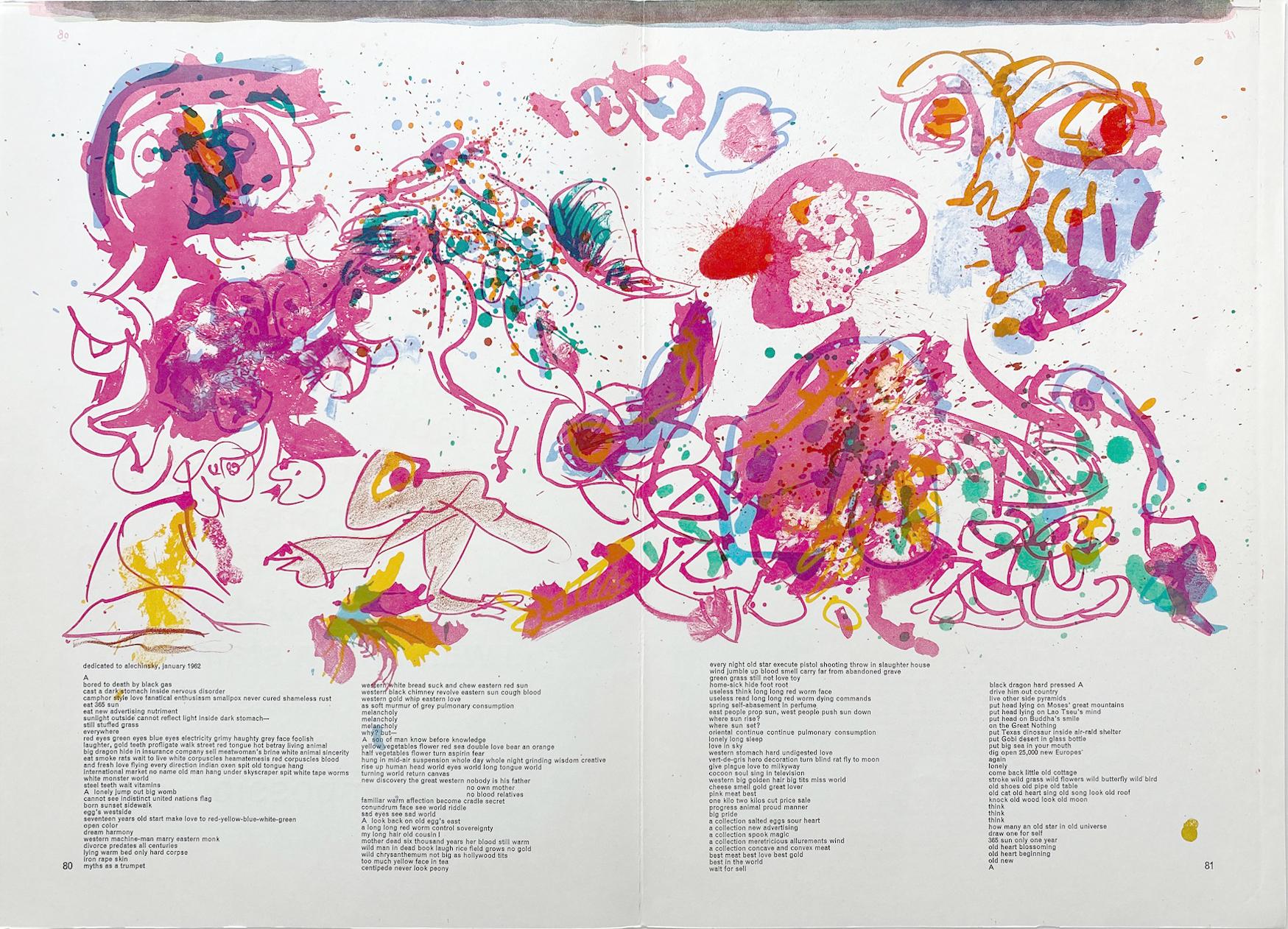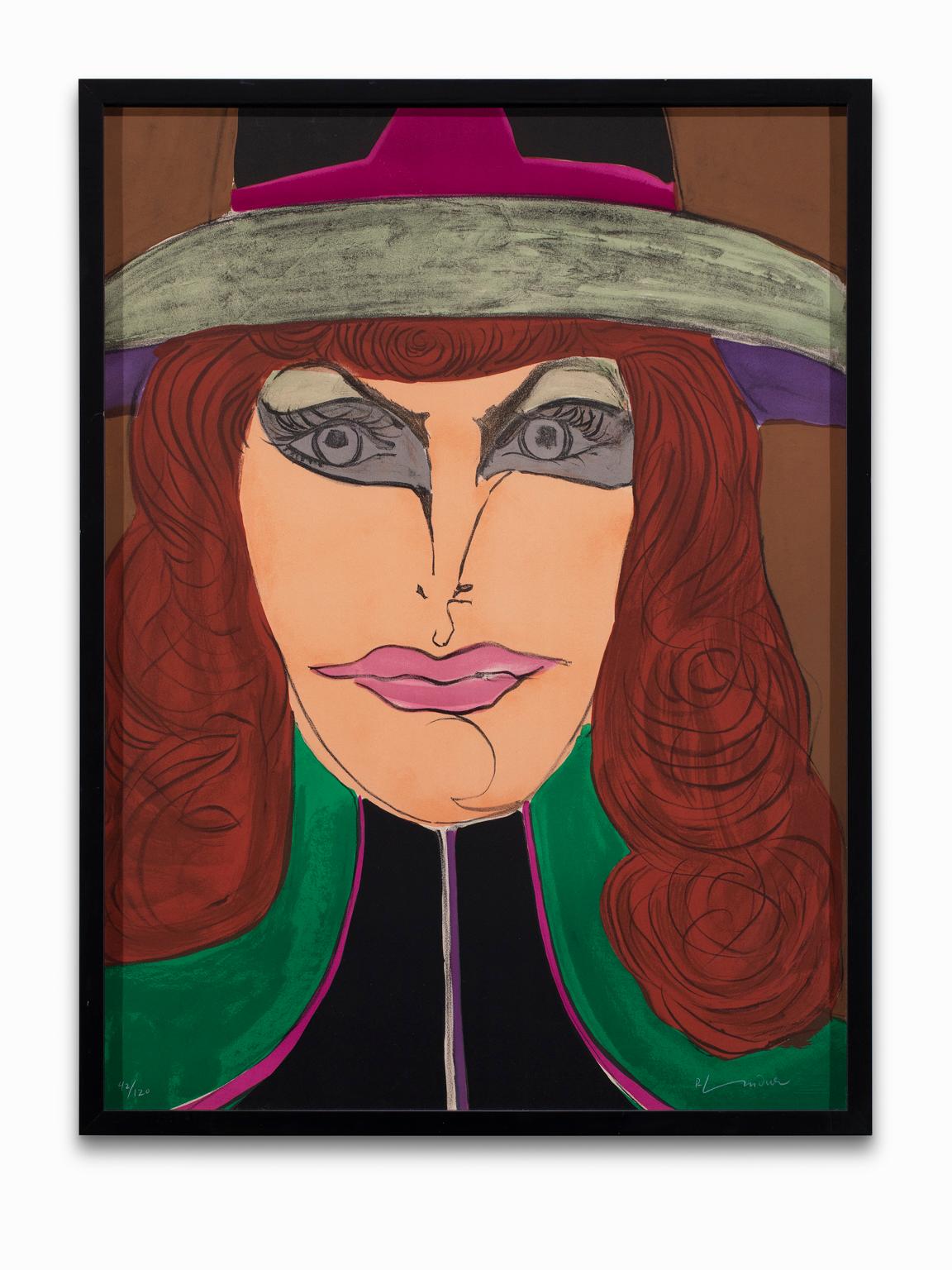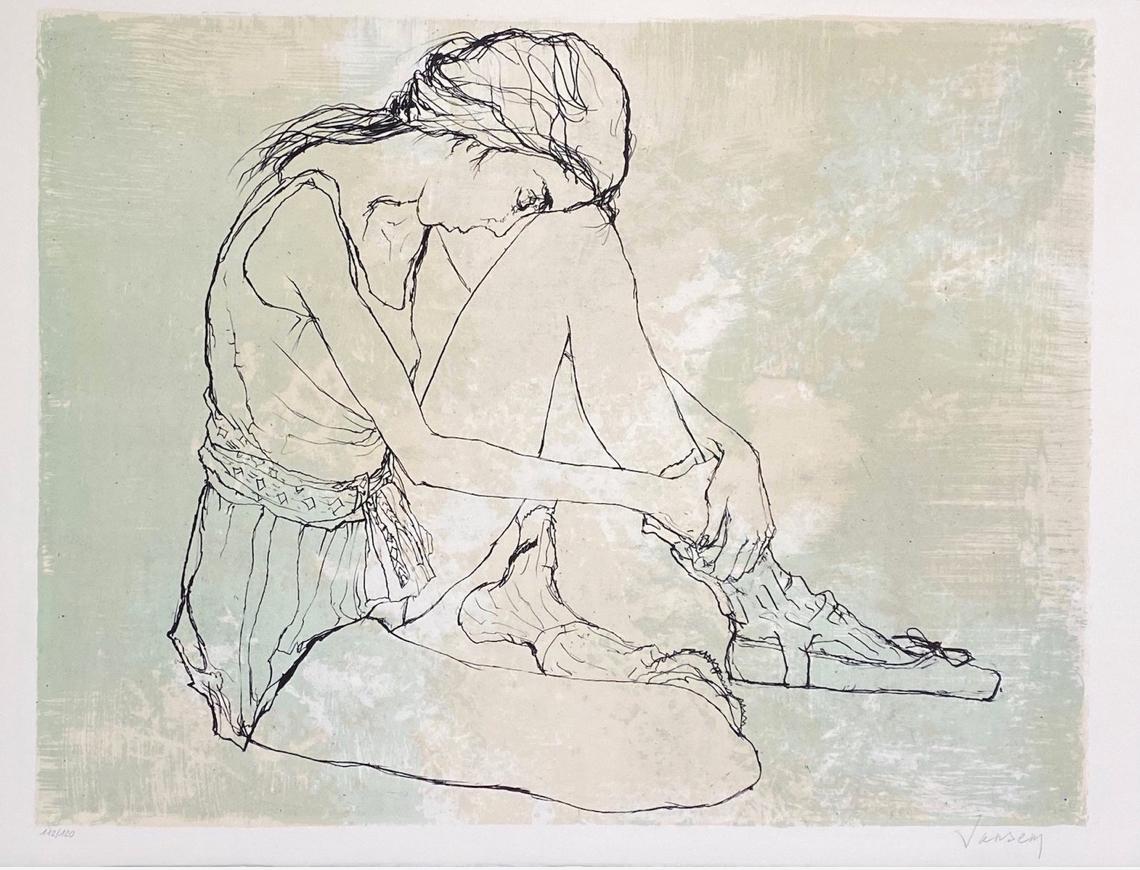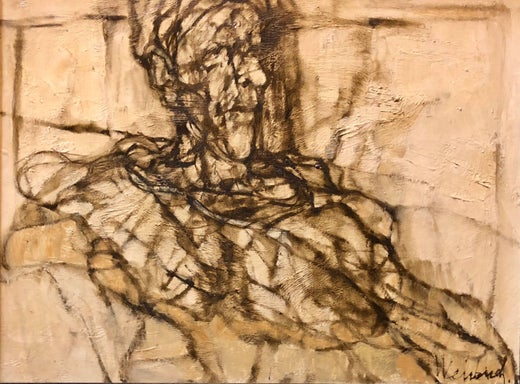Items Similar to Homage a Leonard de Vinci-Front. Self-portrait of de Vinci
Want more images or videos?
Request additional images or videos from the seller
1 of 9
Claude WeisbuchHomage a Leonard de Vinci-Front. Self-portrait of de Vinci1978
1978
About the Item
This is an original color lithograph created by Claude Weisbuch. It was designed to promote his show at Vision Nouvelle, a gallery in France. This show in particular was about his Homage to Leonardo De Vinci series.
Art Size: 23 1/4"x17"
Frame Size: 32 1/2"x26 1/8"
Claude Weisbuch was born in Thionville, France in 1927 and was a pupil at L' École des Beaux-Arts de Nancy, France. As a painter, engraver, and exceptional lithographer, Claude Weisbuch has painted active motifs, such as musicians, horses, and characters. Dominating in his work, by the relief and the velvety line which characterizes drypoint, his etchings are the strongest representations of his figures, intensely lively after the 1960s.
Using dark tones which express his sharp sense, Claude Weisbuch ceaselessly captures life's dynamics, as the pictorial, musical and literary expressions that are essentially human. Whether it is the impassioned violinist, the mercurial actor, or the sitter shrouded with silent intensity, they have all been rendered with Weisbuch's love for drama. The brushstrokes are sweeping and bold while the paint is fluid. His pictures, full of movement, give one the impression of time-lapsed motion and display an expression of passionate humanity tinged with a unique energy. Weisbuch has been quoted as saying, “I like the sketch, the uncompleted, the painting filled with mystery,”.
"Some important things to look for in evaluating an artist for such a position of honour are: an inventiveness of style, a prolific output, and a consistency of quality--Claude Weisbuch has all three. His style is unique with a color range that is rich and warm in tone, certainly equal to that of Rembrandt. The fluidity of line and creation of motion is even more vigorous than in the work of Daumier or Toulouse Lautrec. His creativeness in composition is awesome and seems to have infinite possibilities of variation and vision." - David Barnett
- Creator:Claude Weisbuch (1927, French)
- Creation Year:1978
- Dimensions:Height: 32.5 in (82.55 cm)Width: 26.13 in (66.38 cm)
- Medium:
- Movement & Style:
- Period:
- Framing:Frame IncludedFraming Options Available
- Condition:
- Gallery Location:Milwaukee, WI
- Reference Number:
Claude Weisbuch
Claude Weisbuch was born in Thionville, France in 1927 and was a pupil at L' École des Beaux-Arts de Nancy, France. As a painter, engraver, and exceptional lithographer, Claude Weisbuch has painted active motifs, such as musicians, horses, and characters. Dominating in his work, by the relief and the velvety line which characterizes drypoint, his etchings are the strongest representations of his figures, intensely lively after the 1960s. Using dark tones which express his sharp sense, Claude Weisbuch ceaselessly captures life's dynamics, as the pictorial, musical and literary expressions that are essentially human. Whether it is the impassioned violinist, the mercurial actor, or the sitter shrouded with silent intensity, they have all been rendered with Weisbuch's love for drama. The brushstrokes are sweeping and bold while the paint is fluid. His pictures, full of movement, give one the impression of time-lapsed motion and display an expression of passionate humanity tinged with a unique energy. Weisbuch has been quoted as saying “I like the sketch, the uncompleted, the painting filled with mystery,”. "Some important things to look for in evaluating an artist for such a position of honour are: an inventiveness of style, a prolific output, and a consistency of quality--Claude Weisbuch has all three. His style is unique with a color range that is rich and warm in tone, certainly equal to that of Rembrandt. The fluidity of line and creation of motion is even more vigorous than in the work of Daumier or Toulouse Lautrec. His creativeness in composition is awesome and seems to have infinite possibilities of variation and vision." - David Barnett
About the Seller
4.9
Platinum Seller
These expertly vetted sellers are 1stDibs' most experienced sellers and are rated highest by our customers.
Established in 1966
1stDibs seller since 2017
393 sales on 1stDibs
Typical response time: 2 hours
- ShippingRetrieving quote...Ships From: Milwaukee, WI
- Return PolicyA return for this item may be initiated within 14 days of delivery.
More From This SellerView All
- Original Lithograph Native American Female Figure Portrait Bold Stoic SignedBy Leonard BaskinLocated in Milwaukee, WI"Helen Goes Ahead- Crow" is an original lithograph proof signed by the artist Leonard Baskin. It depicts a Crow woman named Helen Goes Ahead in front of a red background. 19" x 12 ...Category
1990s Expressionist Portrait Prints
MaterialsLithograph, Ink
- "L'Atelier Mourlot Title Page, " an Original Lithograph by Pablo PicassoBy Pablo PicassoLocated in Milwaukee, WI"L'Atelier Mourlot Title Page" is an original color lithograph by Pablo Picasso. It depicts a simplified smiling face in blue, red, yellow, and green with the text "Mourlot Workshop"...Category
1960s Expressionist Portrait Prints
MaterialsLithograph
- 'Babylone d'Allemagne' original lithograph poster by Henri de Toulouse-LautrecBy Henri de Toulouse-LautrecLocated in Milwaukee, WI'Babylone d'Allemagne' or 'German Babylon' is an original lithograph poster by the lauded artist of the Art Nouveau style Henri de Toulouse-Lautrec. This is the second poster that La...Category
1890s Art Nouveau Portrait Prints
MaterialsPaper, Lithograph
- "Satan" from "Je Reve" portfolio, Surrealist Lithograph, SignedBy André MassonLocated in Milwaukee, WI"Satan" is an original color lithograph by Andre Masson. This piece is from the "Je Reve" (I Dream) portfolio of 1975. The edition number, written lower left, is H.C. XXV/XXV. The ar...Category
1970s Surrealist Figurative Prints
MaterialsPaper, Lithograph
- 20th century color lithograph figurative print male subjects sketch scene signedBy Claude WeisbuchLocated in Milwaukee, WI"La Lecon Du Professor Tulp" is an original lithograph by Claude Weisbuch. The artist signed the piece lower right and wrote the edition (ETAT) in the lower left. This piece depicts ...Category
1970s Modern Figurative Prints
MaterialsLithograph, Paper
- 20th century lithograph figurative print male subjects hats dark scene signedBy Claude WeisbuchLocated in Milwaukee, WI"Five Dutchmen with Hats" is an original lithograph by Claude Weisbuch. The artist signed the piece lower right and wrote the edition number (EA 15/30) in the lower left. This piece ...Category
1970s Modern Figurative Prints
MaterialsLithograph, Paper
You May Also Like
- Marc Chagall - Four Tales from the Arabian Nights - COMPLETE SET (12)By Marc ChagallLocated in Los Angeles, CAMarc Chagall (1887-1985) FOUR TALES FROM THE ARABIAN NIGHTS (MOURLOT 36 - 47; CRAMER BOOKS 18) The complete set of twelve lithographs printed in co...Category
Mid-19th Century Expressionist Figurative Prints
MaterialsLithograph, Laid Paper
- Man and WomanBy Akio TakamoriLocated in Kansas City, MOArtist: Akio Takamori Title: Man and Woman Date: 1993 Medium: Lithograph, Rives BFK white Dimensions: 29.5 x 11 inches Editions: 30 Akio Takamori’s evo...Category
1990s Expressionist Prints and Multiples
MaterialsHandmade Paper, Printer's Ink, Lithograph
- Dame mit Reiher (Woman with a Tuft of Heron Feathers) /// German ExpressionismBy Otto DixLocated in Saint Augustine, FLArtist: Otto Dix (German, 1891-1969) Title: "Dame mit Reiher (Woman with a Tuft of Heron Feathers)" *Signed and dated by Dix in pencil lower right Year: 1923 Medium: Original Lithograph on light smooth wove paper Limited edition: approx. 120 Printer: likely the artist Dix himself, either Dresden or Düsseldorf, Germany Publisher: Euphorion Verlag, Berlin, Germany for the "Die Schaffenden" Vol. 5, No. 1. portfolio Reference: "Otto Dix: Das Graphische Werk" - Karsch No. 62/II c, page 84, 147 Sheet size: 16.25" x 12.25" Condition: In excellent condition Rare Notes: Provenance: private collection - Robert Kuennen, Oberlin, OH. Euphorion Verlag chop mark/blind stamp lower right. Pencil inscribed "Dix Fraukopf (Dix Woman Head)" at lower center. Biography: Otto Dix (born December 2, 1891, Untermhaus, Thuringia, Germany—died...Category
1920s Expressionist Portrait Prints
MaterialsLithograph
- "Untitled": Lithograph from One Cent LifeBy Pierre AlechinskyLocated in Austin, TXArtist: Pierre Alechinsky Title: "Untitled": Lithograph from One Cent Life Year: 1964 Medium: 2 page lithograph, as printed from One Cent Life As printed with Walasse Ting poem, fro...Category
1960s Expressionist Portrait Prints
MaterialsLithograph
- Richard Linder "Red Head" Lithograph Figurative PortraitLocated in Detroit, MI“Red Head” is a portrait that puts dynamic and powerful to shame. This woman from the 1970s at the height of the Feminist movement is an Amazon. Though you cannot see her body her powerful and determined gaze is that of an individual who knows where she is going and what she wants. Best if you get out of her way. Nonetheless, the aura she creates is hypnotizing and the viewer must struggle to break the spell or be absorbed into her presence. This spell-binding piece of Linder’s is unique in its ability to exude a physical push and pull upon its audience. Richard Linder...Category
1970s Expressionist Portrait Prints
MaterialsLithograph
- Repos, 1999, original lithograph by Jean Jansem handsigned numberedBy Jean JansemLocated in Carouge GE, GEJean Jansem (1920-2013) Repos, Album Danse, 1999 Lithographie sur papier Arches Signée et justifiée 50 x 65 cm / 54 x 76 cm Imprimeur: Mourlot, Paris Editeur: Jansem, Paris Bibliographie: Jansem Lithographe, 1993-1999, Flora Jansem, Paris, n. 155, reproduit p.81, référencé p. 97. "Ma première lithographie date de 1954. Elle représente un enfant en haillons portant deux seaux d'eau, d'après un croquis rapporté de Cordoue lors de mon voyage en Espagne en 1952. Je l'exécutai sur pierre, au pinceau et à l'encre lithographique. Je fus déçu du résultat et n'en tirai qu'un essai et une épreuve. Quatre ans plus tard, je réalisai une dizaine de nouvelles lithographies, toujours sur pierre, la plupart en noir. Au lieu d'employer l'encre et le crayon lithographiques, j'utilisai l'encre zincographique plus fluide me permettant de travailler à la plume ou avec de fins pinceaux de martre. Le tirage fut très satisfaisant. au grand étonnement du Père Guillard, lithographe. Jusqu'alors l'encre zincographique ne servait qu'à la zincographie. Actuellement elle est d'un usage courant puisque pratiquement toutes les lithographies se font sur zinc et non plus sur pierre, ce qui facilite la manipulation. Par ailleurs, le zinc offre autant de possibilités que la pierre. En 1959, La Guilde de la Gravure me demanda une édition en couleur. Je choisis une nature morte aux chardons, tirée à 220 exemplaires. Par la suite, les tirages varièrent de 10 à 160 épreuves. Mes lithographies en couleur étaient assez proches de mes toiles. A partir de 1968, période de La Danse, je supprimai petit à petit le clair-obscur et la matière pour donner plus de légèreté et de transparence. Les lithographies postérieures à 1970 sont dessinées en noir sur un fond coloré souvent volontairement arbitraire, donnant l'aspect d'un dessin rehaussé. La couleur n'est pas intégrée au dessin mais joue un rôle d'accompagnement du trait qui est lui-même une arabesque écrite. Quand le noir...Category
Late 20th Century Expressionist Figurative Prints
MaterialsLithograph
Recently Viewed
View AllMore Ways To Browse
Portrait Of Leonardo
Vintage Rembrandt Prints
Rembrandt Self Portrait
Rembrandt Self Portrait Etching
Lautrec Etching
David Leonardo
Original Lithograph Rembrandt
Daumier Etchings
Weisbuch Claude
Weisbuch Lithograph
Claude Weisbuch Lithograph
Picasso Print 1969
Hand Colored Etchings
Bachelor Prints
J Colored
Retro 1960s Posters
Vintage Book Light
Russia Book
